Let grass grow for wildlife: Carlisle’s Conservation Grasslands & Wildflower meadows
How the short ‘weedless’ lawn became popular
If you look at almost any verge, home, or park, small or large, you will see a lawn. Regularly cut short grass free of ‘weeds. They have their uses for recreation including sports, events, picnics, even BBQs and as formal decoration. But where does this popular fashion come from?
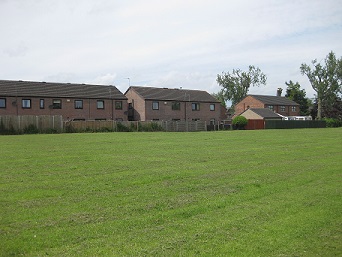
The first lawn in history, created purely for show, was most likely in France when André Le Nôtre designed the gardens of Versailles for Louis XIV at the end of the 17th century, launching the jardin à la française (French formal garden). This huge area was mowed by gardeners with scythes. The idea behind the French formal garden was geometric and precise to show the power of man over nature.
Soon these ‘green carpets’ were copied all over Europe by the nobles. Only large, wealthy landowners could afford to hire lots of people to scythe and weed the grass. Having a short lawn was a symbol of wealth and status.
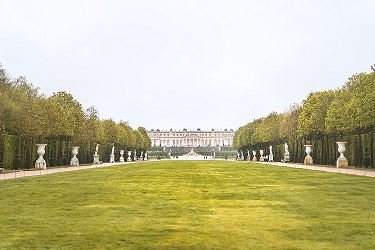
Above: Garden of versailles by Andri Klopfenstein on Unsplash.
However, this manicured trend was wiped out less than a century later by the idea of an English landscape garden, influenced by designer Capability Brown. This style was a more natural look, back to nature but improved by human hands. But the short lawn remained, mainly created by cattle and sheep. Think grounds like in the TV series Downton Abbey – only the richest could afford to have big pieces of land used only for show and garden parties.
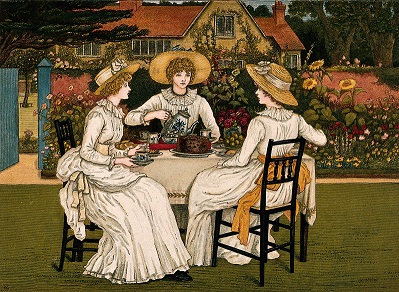
Above: A Victorian garden party on the lawn by Wellcome Library, London
Suddenly, the lawn mower was invented in the 1830s by Edwin Budding. Making it affordable to cut your own lawn – if you were middle class. In the Victorian era, sport that needed flat grassy surfaces made lawns even more popular – croquet, tennis, bowls, and polo.
A new revolutionary idea arose at this time – that it was healthy to be outdoors in a natural setting. This idea led to city parks dominated by the lawns we see all over cities today. Most city parks are ‘English Landscape gardens’ without the castle/manor. In the 1870s, the North Americans followed our European fashions first in countryside then in the newly created suburbs to show their status.
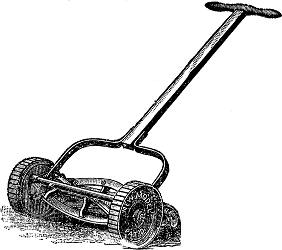
Above: An early cylinder (reel) mower, showing a fixed cutting blade in front of the rear roller and wheel-driven rotary blades.
However, these lawns did still have value to wildlife, they were made up of of plants which grew naturally, a mix of clover, plantain, dandelions, and other plants. The idea of a ‘weed’ had not yet emerged. However, the lawn industry began to take hold – instant lawns with rolls of turf and seed mixes created for perfect lawn, not for pasture. Cheap mowers, accessible cars and working weeks with Saturday off to mow the lawn, led to the lawn fad and even some regulations requiring homeowners to have a lawn.
After World War 2, golf help create a culture of removing any plant apart from grass. So, when herbicides arrived that could kill most plants in a lawn, most people used them in the search for a ‘perfect lawn’. This included really beneficial plants like clover and dandelion. Clover, a plant widely used by farmers to improve pasture, was once considered a healthy part of lawn as has a special ability to take nitrogen from the air and put nitrogen back into the earth, helping plants like grass keep healthy. But it was considered a ‘weed’. From the 1950s to 2000s the ‘perfect lawn’ was what we often see today – just regularly cut short grass. No long grass dandelions, clover or the wildlife that comes with it.
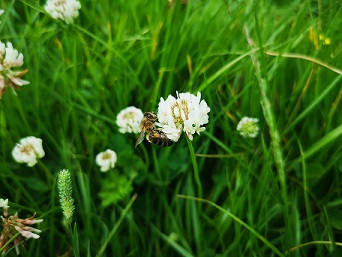
Above: A honey bee on white clover.
Now things are slowly changing - we are planting more vegetables, growing grasses, and wildflowers, leaving areas to grow ‘wild’. The lawn still has a place, but can we let nature grow alongside?
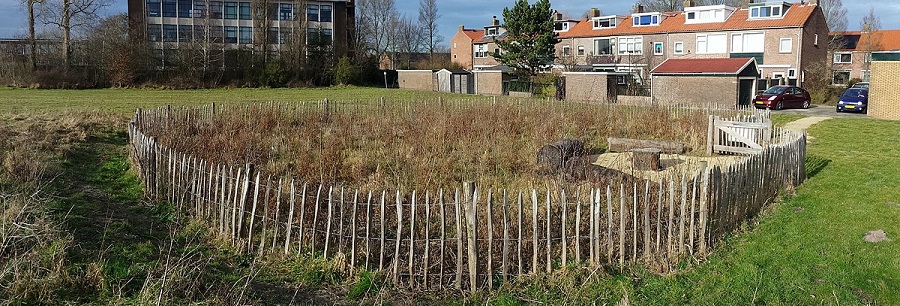
Above: ‘Tiny Forest Netherlands - creative commons’ – The Netherlands have planted over 140 ‘tiny forests’. “Tiny Forest is more than just trees. This amazing phenomenon reconnects people with nature, enhances wellbeing, helps mitigate the impacts of climate change and provides nature-rich habitat patches to support urban wildlife.”
The Importance of Long Grass
Short grass may appear neat and tidy- it’s what a lot of us have grown up with – but long grass provides so many benefits to wildlife. Short grass provides not much in comparison. When the grass can grow long, it opens a world of small ‘microhabitats’ for wildlife. Basically, long grass means more space and structure for a greater diversity of insects and other arthropods.
If you type grass and insects into google, there’s a good likelihood you will get a flood of search results on how to get rid of insect ‘pests’ in your lawn. To some, insects might seem tiny, insignificant and a nuisance, but insects give us so much: they pollinate 80% of our flowering plants, they decompose, create nutrient rich soils, disperse seeds, maintain our healthy soils, provide free ‘pest control’ as predators and are themselves a huge food source for lots of wildlife. They are at the foundation of the food web. Without insects we would not have the plants or animals we rely on to live.
.jpg?ver=RRQPjBAmIADkl9tSb1Gf3w%3d%3d)
Above: This common and widespread bug (Closterotomus norwegicus) can be found in meadows and hedgerows across Britain, where it feeds on a wide range of plants, especially nettles.
Think like an insect – there are 27,000 different species of insects in the UK, they all have different needs – like us! Globally for every person there are about 1.4 billion insects, and their total weight about 70% more than all humans combined…
But there is compelling evidence (globally and in the UK) that insect populations are in decline. One recent estimate in the UK suggested a 58% loss in abundance between 2004 and 2021, using data based on insects “splatted” on car number plates.
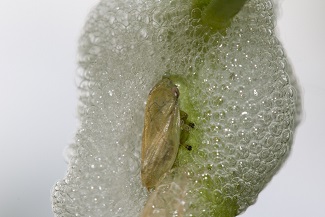
Above: Have you ever seen what looks like spit on the top of grass in spring/summer – that’s cuckoo spit. The sticky substance is made to protect the baby frog hoppers. If grass is left to go wild, the common froghopper will quickly move in. They are tiny, so to reach new areas, they fly high in the sky, carried by the wind. Swifts and swallows try grab them for their lunch. Credit to Steve Begin on flickr.
Long grasses provide food, shelter, and breeding grounds for insects. Insects need grasses to go through all their stages of growth, they need grass flowers (called spikelets), grasses to set seed, dead seed heads, the stems of grasses. Insects also need lots of diversity in plants and grasses, for example some insects need plants earlier or late in the year. This provides year-round feeding, breeding, and overwintering sites. Many insects spend part of their life cycles in dead stems, grass sheaths and seed heads so a cut at any time of the year could be disastrous.
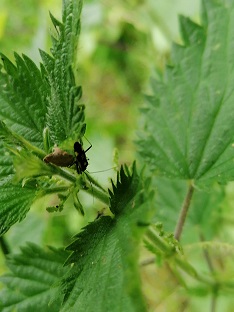
Above: We often walk by nettles ang get annoyed at their stingers, but they support more than 40 species of insects. Nettle seeds are loved by aphids, and aphids are an essential food to birds and ladybirds. Credit to Bryony Hawkes.
When people think meadows, they often think solely about the flowers and pollinators, but there is more to it than that:
- Grass is food
- Lots of insects eat grasses in different ways;
- Some insects chew, scrape, or suck on leaf tissue – like the grasshopper.
- Some insects feed on the sap, like aphids, leafhoppers and planthoppers.
- Some insects bore into the plant – like leaf miners, gallers and borers.
- And some insects eat the stems of grass.
- Grass is needed to lay eggs
- Many insects will only lay their eggs on one food plant and rely on these to complete their whole lifecycle.
- Grass is a home for shelter
- Plant seed heads and hollow stems like thistles and knapweed give dry shelter and food over winter.
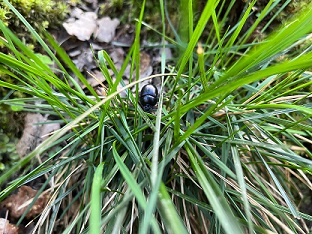
Above: A beetle in grass, beetles are predators of other insects like aphids. Credit to Bryony Hawkes
Here are some of the other needs of insects:
- Changes in the ground - Slopes, banks, hummocks and even piles of rubble, these little changes create wetter areas, overwintering sites, warm and droughty areas – different insects like different homes.
- Lots of different structure in the grasses – Patches of bare ground, patchy scrub. Short open turf, tall grass and tussocks. These differences provide different nesting/overwintering sites for insects like bumblebees, ground beetles and food plants for caterpillars.
- Other habitats nearby – They need areas like shrub and hedges so they can find homes/food they can’t find in the grassland when they reach a new life cycle. So, they can feed, rest, lie in the sun or use them as a corridor to get to more habitat.
But it’s not just insects, spiders can spin webs from the tall grass to catch flies. Spiders’ webs can be seen in the morning dew. Not all spiders stay in their webs, many hunting spiders will creep through the grass and catch unwary insects while also falling prey themselves to hedgehogs and blackbirds.
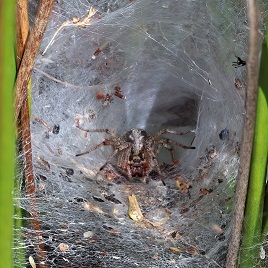
Above: The Labrinth spider – they lay complicated traps in uncut grass to catch bulky, athletic insects like grasshoppers - Wikimedia Commons, the free media repository.
Long grass improves conditions for invertebrates, which in turn provides food for birds and mammals such as hedgehogs and bats.
Bats eat so many insects that their droppings can be distinguished from mice droppings (they both look like long raisins) as bat droppings are crumbly if you dare to rub them between your fingers. Mice droppings are often moist. Insects have a hard ‘exoskeleton’ so if you eat lots of them, like bats, your droppings would be very crumbly.
.jpg?ver=jZUVZ0v3Mul0pWVaHYhrCA%3d%3d)
Above: A Pipistrelle bat. The common pipistrelle is so small, it can fit into a matchbox! Despite its size, it can easily eat 3,000 insects a night like flying midges and moths.
Look out for reptiles – they are very shy! They are active in March to October. Common lizards and slow worms are especially common.
.jpg?ver=_gxVmSXUT-D4JHQXu6JNZw%3d%3d)
Above: An adult female slow worm – they aren’t slow or worms! They are leg-less reptiles.
Even small spaces are invaluable for them when allowed to grow long grass and shrub: gardens, school grounds and allotments. Slow worms love a warm compost heap. These networks of small sites help connect and sustain reptiles.
Reptiles need areas of long grass as a refuge. They do not cope with extreme temperatures and need places they can hide from wind, predators, and direct sunlight (although they do like to bask in the open between 8 and 18 °C). South facing banks are ideal conditions for reptiles. They also need areas to hibernate over winter.
Mowing large areas of ground can create habitats that are too uniform and may harm reptile populations. Reptiles love to use the edge of habitats, such as between where the grass is long and short so they can bask in sunshine and then run to safety.
Leaving some areas uncut throughout the year allows invertebrates to shelter and breed. Species of moth and butterfly, as well as craneflies and sawflies, find this invaluable. These provide a source of protein-rich food for mammals and birds and are particularly important for the survival of young chicks. Long uncut grass provides great habitat for moth caterpillars which are blue tits' favourite food. So voracious is the appetite of a large brood of blue tits that the family is capable of eating more than 10,000 caterpillars before they finally leave the nest. Uncut grass can also provide seed for birds. Those of annual meadow grass, plantain and buttercup are favourites.
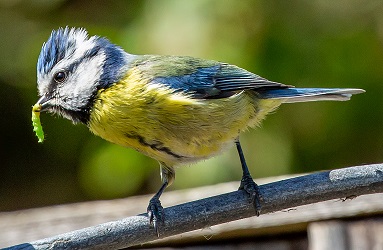
Above: Image of a blue tit happily eating a caterpillar, by Kev from Pixabay.
Although they breed in ponds, amphibians spend much of their time on land. Their terrestrial habitat requirements are simple – they need cover to provide damp resting places and to support the insect prey on which they feed. Areas of long grass provide a refuge for amphibians, such as frogs and newts. The moisture collected on grass stops the desiccation of small amphibians during the driest parts of the year. Which is even more important for dealing with the effects of climate change.
.jpg?ver=e89LqVqMcJ8XobYykxIFyw%3d%3d)
Above: Common froglet
A fifth of all priority species for conservation action are associated with grassland habitat. Mammals feed on grassland seeds and invertebrates. Reptiles and amphibians will also search for invertebrates in grass and use it as shelter when moving between sites. Longer swards help retain soil moisture and humidity which benefits many varieties of invertebrates such as worms, beetles, butterflies, grasshoppers, crickets and spiders living in the soil.
Why is long grass good for people?:
- Carbon sequestration - Grassland soils store carbon dioxide. UK grasslands store 2 billion tonnes of carbon in their soils. Grasslands have a huge potential for locking up carbon, not only due to the plants we can see on the surface, but also due to the relationships between the plants, fungi, bacteria, and many other species which help enrich the soil with carbon.
- Reduced flooding – Flower-rich flood plain meadows have absorbent soils so reduce flood waters more than amenity or farmland grassland.
- Pest control - Being close to semi natural grasslands increases the number of predatory insects which control agricultural pests.
- Green network – Patches of long grass connects to other patches of habitat maintaining biodiversity.
- Help reduce pollution - Biodiverse grasslands absorb more pollutants reducing impact to air and water.
- Protects soil from erosion – longer grass can grow longer roots and stabilise the soil.
- Economic sustainability - The maintenance of long grassland or species rich grassland costs less than amenity grassland.
- Increased wellbeing and better mental health – Being outside in nature with more wildlife and opportunities for all to watch insects and children to play and explore long grass.
- Social benefit - Opportunities for education about species rich grassland and wildlife. Brings a little piece of the countryside into the town. Tall grassland is attractive to young children stimulating imagination and play, introducing them to wild habitats.
- Carbon sequestration - Grassland soils store carbon dioxide. UK grasslands store 2 billion tonnes of carbon in their soils. Grasslands have a huge potential for locking up carbon, not only due to the plants we can see on the surface, but also due to the relationships between the plants, fungi, bacteria, and many other species which help enrich the soil with carbon.
- Reduced flooding – Flower-rich flood plain meadows have absorbent soils so reduce flood waters more than amenity or farmland grassland.
- Pest control - Being close to semi natural grasslands increases the number of predatory insects which control agricultural pests
- Green network – Patches of long grass connects to other patches of habitat maintaining biodiversity
- Help reduce pollution - Biodiverse grasslands absorb more pollutants reducing impact to air and water
- Protects soil from erosion
- Economic sustainability - The maintenance of long grassland or species rich grassland costs less than amenity grassland
- Increased wellbeing – Being outside in nature with more wildlife and opportunities for young children to play in long grass and watch the insects brings joy to life.
- Social benefit - Opportunities for education about species rich grassland and wildlife. Brings a little piece of the countryside into the town. Tall grassland is attractive to young children stimulating imagination and play, introducing them to wild habitats.
Our conservation grasslands initiative
We have designated 7 new conservation grassland areas in 7 of our greenspaces, totalling 8 hectares of grassland being managed for pollinators and other wildlife.
- Chances Park
- Hammonds Park
- Heysham Park
- St James Park
- Parkside
- Briar Bank
- Willow Holme
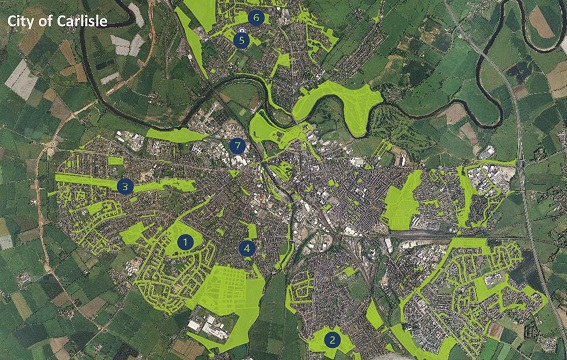
In our amenity short grassland, we cut between April and October and it can vary between 2-3 weeks depending on weather, ground, and growing conditions. In our conservation grassland areas, we are managing the area for the benefit of wildlife; we let the grass grow long from spring to summer and cut the grass annually in August-September. We have conservation areas in the middle of shorter grass or with short grass borders to give a ‘tidier’ appearance and to show these areas are purposely being left to grow. The grass is cut in autumn as if never cut it would eventually try to turn into scrub or woodland.
We are also trialling taking away the grass cuttings from one site – Heysham park. There is an expense to this without machinery in house but removing the grass cuttings has been shown to reduce the nutrients in the soil. We may also trial removing the grass cuttings with volunteers. Wildflowers prefer lower nutrient soil, so removing the cuttings gives space for wildflowers and more slower growing grass species to grow, making the area more biodiverse.
We are working with the University of Cumbria to survey and monitor the conservation grasslands to evidence our grassland scheme. Students from the university have also been ambassadors for our scheme, talking with the public about the benefits of grasses and wildflowers.
We will be looking to expand the scheme in the future to more sites and buy our own equipment to remove the cuttings from conservation grassland sites. We will also be reaching out to communities to raise awareness about the need for long grass and wildflowers for our insects and other wildlife.
You might have spotted the green spaces Cumberland Council have already gradually left, like Melbourne Park and Upperby cemetery, to grow longer grass and wildflowers. They can be seen to have had some great results already.
Top left: Wildflowers in bloom on grass bank in Brampton. Top middle: Swathe of bluebells in Upperby cemetery. Top Right: Wildflowers and long grass in chances park. Bottom left: The swifts – Honey bee on white clover (this flower is also called bee’s bread because bees love it!). Bottom right: A bank in Melbourne park left to grow wild for wildlife
We need your help, when you next see some long grass or wildflowers growing on one of our sites let your friends and family know why the council is cutting some of the grass less often. Post on social media and let us know what you think of the changes to parks for wildlife. Take your children, friends or just yourself to have a look at the insect life in spring/summer. Even better... replicate some of the results in your own garden!
Creating wildflower meadows small and large
We are encouraging, supporting and creating wildflower meadows small and large across Carlisle.
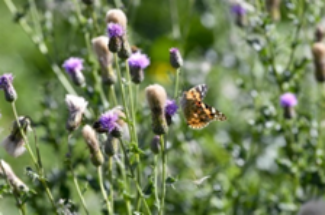
We have created a new 42-acre wildlife haven for birds, bees and butterflies in Carlisle. The Swifts golf course and driving range in Carlisle city centre has become one of the very first urban bee and butterfly oasis in the Northwest. The Swifts site, in the centre of Carlisle, includes grassland, woodland and riverbanks. It has been transformed into an urban nature reserve thanks to £80,000 funding from Cumbria Waste Management Environment Trust (CWMET) and £8,000 from the Environment Agency. The funding has breathed new life into the site, transforming once manicured greens and fairways into wildflower meadows, species-rich wetland and native woodland, helping to boost populations of bees and butterflies.
The site is owned by Cumberland Council, who worked collaboratively with Cumbria Wildlife Trust to ensure the successful delivery of the project. With improved access and signage, and within close walking distance of Carlisle city centre, the site is an oasis for wildlife and visitors to the site. The funding has been secured by Cumbria Wildlife Trust, and working in partnership with Cumberland Council, the restoration works were part of Get Cumbria Buzzing! The project is supported by The National Lottery Heritage Fund and aims to create and link pollinator habitat across northwest Cumbria.
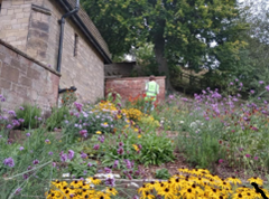
The Friends of Rickerby Park (FRP) inspired by the Swift’s Nature Reserve and as neighbours across the River Eden they now both provide a wonderful benefit for the community and wildlife. Their recent work in Eden Bridge Gardens (EBG) includes a refurbished historic top pond and fountain, a restored rose bed along the pagoda, and a new pollinator flower bed – for which we have received lots of praise from many people passing by.
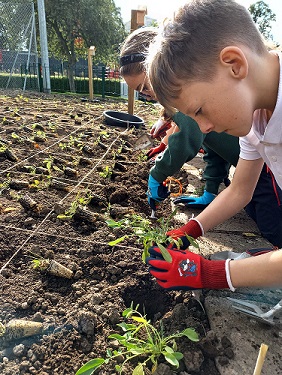
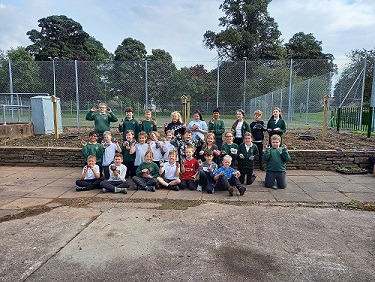
Cumberland Council and 4 Carlisle schools (5 classes) explored the diversity of pollinators and why they are important through a day of pollinator activities to get them inspired to design a raised bed in bitts park for pollinators. This project, with Cumbria Wildlife Trust, is part of ongoing works by the Council to improve our green spaces for pollinators and wildlife. The school children’s vision has now been made a reality – with a new flowerbed - designed by them in Bitts Park. The flowerbed includes 4 mini ponds, 4 solitary bee hotels, pollinator painted rocks which surround the ponds for easy access for wildlife, and a planting scheme of a bold blue river surrounded by colours designed and planted by the winning school – St Bedes.
This park contains a hay meadow created in 2014 by Friends of Chances Park. A Hay Meadow is a long strip of grasses and some wildflowers typically found in traditional hay meadows in North Cumbria. This area is mown annually, and a hay crop removed by local contractors. Friends of chances park raised funds to increase the biodiversity of this hay meadow and fill it with more coloured flowers. The local school – class 2 and 3 came down and planted 300 plugs an learnt all about pollinators through a game of pollination – they became the hungry bees pollinating the flowers as they flew! 12 people from the local community also helped plant 400 plugs on a public planting day.
Working with Friends of Hammond Pond we aim to create a wildflower area near to the entrance of Hammonds Pond.
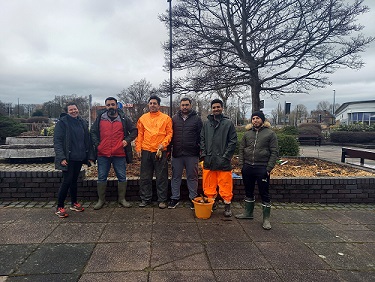
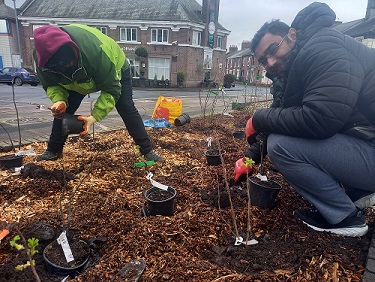
A mixture of native and cultivar rose species loved by pollinators have been planted by men from the diaspora group to help pollinators and improve a disused bed outside of the civic centre. The bed aims to raise awareness about the types of flowers pollinators need. With roses, cultivated commercial roses often have been bred to have many petals so pollinators can’t enter the flower. Open roses with far fewer petals are much easier to get inside.
Our Wildflower Meadows are shrinking… While meadows have taken 6,000 years to create, since the 1930s we’ve lost 97% of species rich grassland. Most of the loss of species rich grassland have been driven by farming and land use change. This loss is one of the main causes of the decline in pollinators and birds. The rate of extinction of wild pollinators is eight times faster than that of mammals, birds and reptiles. If this decline continues, at the current pace, then in 100 years there'll be far fewer or, as some scientists report, maybe no insects left.
Species rich grassland is home to a large variety of wildflowers supporting many threatened species of plants, insects, and birds.
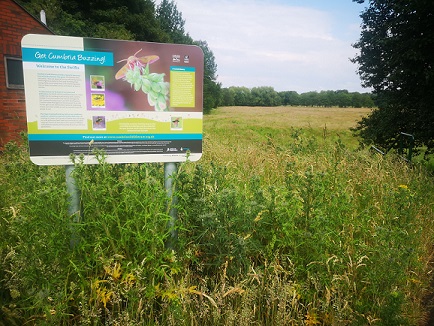
Above: A newly created wildflower meadow in the centre of Carlisle – the Swifts
Our meadows are made up of native plants – meaning they occur naturally in the region they evolved. We leave the plants to flower and seed before mowing once in September which helps the seed to spread. We then remove the cuttings which makes the soil less fertile and helps the flowers compete with the grass.
There’s so much more to a wildflower meadow: it supports a whole ecosystem! Key to a meadow is a semi parasitic wildflower like Yellow rattle: Brush your hand over the top of yellow rattle and you’ll hear a rattle from the tiny seeds inside. Their special ability is to live a semi parasitic life by feeding off nutrients in the roots of nearby grasses. By feeding off the vigorous grasses it allows more delicate wildflowers to push their way through.
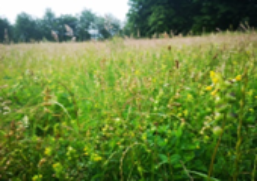
Above: Yellow rattle in the Swifts
Wildflower-rich grasslands are the most important habitat for bumblebees as they provide plants throughout the summer and contain many nectar- and pollen-rich plant species. Wildflower meadows can contain up to 40 plant species per square metre.
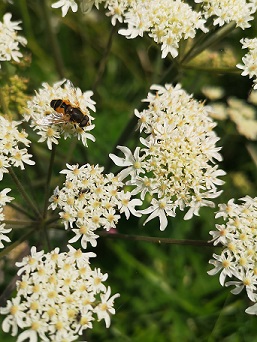
Above: Hoverflies are one of our most important pollinators. They are flies but look like bees!
We need your help, when you next see some long grass or wildflowers growing on one of our sites let your friends and family know why the council is cutting some of the grass less often. Post on social media and let us know what you think of the changes to parks for wildlife. Take your children, friends or just yourself to have a look at the insect life in spring/summer. Even better... replicate some of the results in your own garden!
'Grassy' SpeakEasy Poetry
A group of poets from the local community meet on the last Wednesday of every month at the Source in Denton Holme. Inspired by wildflowers and grasslands, they kindly donated some time to write imaginative poems. Take a look at the 8 poems below, we aim to put these up around the conservation grasslands. We want to help showcase the talent of people in Carlisle and show what growing the grass long means to them. Let’s grow Carlisle together .
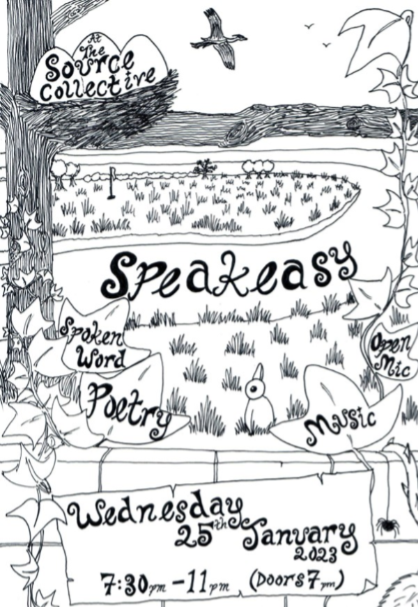
Down with strimming
Down with mowing
Down with spraying
Down with spraying pesticides
Down with spraying herbicides
Down with monotonous plants in rows in ranks in blocks
Down with flowers which insects can’t use for food
Down with plants which birds can’t use for food
Down with Plants which beasties can’t use for shelter
Down with Plants without smell or use
Down with those plants which dominate local plants
Up with Wild Plants
Up with Wild Grasses
Up with Wild Herbs
Up with Weeds
Up with wildlife
Up with worms
Up with variety
Up with insects
Up with bugs
Up with moths
Up with flies
Up with Bees
Up with beasties
Up with soil
Up with wild corners
Up with longer grass
Up with thick hedges
Up with native trees
Up with native shrubs
Up with Voles and hedgehogs and shrews and stoats
UP WITH grasshoppers and greenfinches and skylarks and linnets and owls and sparrows and great tits blue tits redpolls thrushes robins wrens dunnocks blackbirds swifts crickets ladybirds weasels foxes moles blackcaps magpies hawks otters badgers lizards snakes frogs newts toads ….
UP WITH wild plants wild animals wild places and more wilderness in our parks and gardens on our verges in our cemeteries in our towns and villages All around us Wildlife needs all the help we can give Now as it’s being lost NOW We don’t act as we don’t care as we think all will be well. Will it?
Grass, the carpet of the East African Savannah.
Where our ancestors first walked upright,
Their too feet brushing against the soft flickering waves as they dance, hunt and travel.
Lightly tickling hairless soles, the connection with he earth is immediate, intimate.
Where we first made tools, gave each other names, sang songs, gave voice to our deepest fears and out most cherished loves. Where we told our first stories.
The story of who we are starts on grass before we turned that grass to papyrus and continued the story there as we fashioned it with our opposable thumbs into ropes that bound our world together.
Grass is home and is where we will always return.
Cutting the grass short
Is like cutting your soul short
Before it feels the joy of life
A new born world,
A brand new ecosystem,
Growth unbound.
Long grass and plants thrive,
Insects, Pollinators, life anew.
The Countdown had Started and could not be stopped
life from lifeness,
A explosive growth of Hope!
Grassy fonds wave at us
As we wonder through the wilderness reclaimed
Ghostly golfers’ birdies on the fairways
Faintly echo between brambles and briar
Grass growing longer makes more of a home for insects, bees, and birds.
Wildlife thriving in the rewilded spaces
We reclaim
On their behalf.
I shave every day before work.
At weekends and holidays, I don’t always shave.
Letting grass grow is the same.
It reminds the outdoors to relax and not work too hard.
Let our open space set the tone for the humans.
Relax in the park.
Militaristic haircut, Militaristic grasscut,
Militaristic culture, Militaristic Death!
Golf. A good walk ruined by muppets
Insect numbers halved since 2004…why bother
Woodn’t yew prefir trees, yew ash
Imagine the golf course uninhabited, uncultivated and inhospitable. That’d be WILD!
Give back to nature or we're all dead
The best time to re-wild the golf course is before it was built,
The second-best time is today!
De-wild everything! Concrete planet! Short, gray future!
Save the planet, ‘cause obviously, it's where you bloody live.
The insects’ revenge will be post humous
Whooshing, swaying, pendulous blades o’ yellow and green, towering, breathing an’ weeping trees a’ healing,
Carve you’re walk, locals to parks,
Water beside to ease and find new tide
Clear Solace to mind.
Below insects below, weave and row
Life is all about growth
But you don't let me do that.
Forever underfoot,
I try to find my way.
Are you in control?
Stand up and be counted
Is what you always tell me
But then you cut me down
and turn me into hay
I burn easily…
But fire is catching.